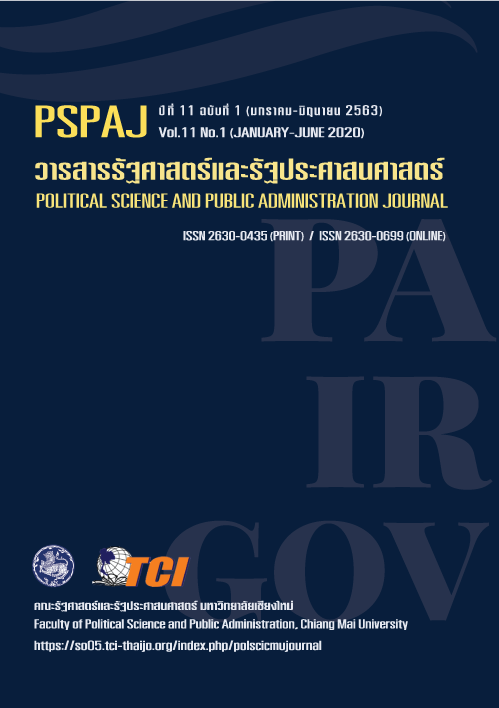Cross-border Trade Network in Thai-Laos Borderland
Main Article Content
Abstract
Cross-border trade is a form of border trade which operated by border traders. The article adopts an approach, proposing that border trade has unique characteristics, which are different from trade in other areas in general, due to physical and socio-economy conditions of border area. The main argument of the article is that cross-border trade in the border area of Thai-Lao is contributed by the “network” of cross-border trade that drive local businesses. The cross- border trade network serves as a mechanism facilitating trade and reducing transaction cost. In addition, the cross-border trade network serves as a social space for facilitating information exchange and enabling new business opportunity. Moreover, it is a mechanism used for breaking through the state regulations that do not support the practices of cross-border traders. For the border studies theory, the article suggests that intensive economic associations between countries do not lead to borderlessness, but contribute to the formation of various types of borders. As such, this study suggests that “border” should be considered as a space of diverse social interactions which encompass diversity, complexity and dynamic.
Article Details
- เนื้อหาและข้อมูลที่ลงตีพิมพ์ในวารสารรัฐศาสตร์และรัฐประศาสนศาสตร์ถือเป็นข้อคิดเห็นและความรับผิดชอบของผู้เขียนบทความโดยตรง ซึ่งกองบรรณาธิการวารสารรัฐศาสตร์และรัฐประศาสนศาสตร์ ไม่จำเป็นต้องเห็นด้วย หรือร่วมรับผิดชอบใดๆ
- บทความและข้อมูล ที่ได้รับการตีพิมพ์ในวารสารรัฐศาสตร์และรัฐประศาสนศาสตร์ ถือเป็นลิขสิทธิ์ของวารสาร หากบุคคลหรือหน่วยงานใดต้องการนำข้อมูลไปใช้ประโยชน์ในทางวิชาการ ขอให้อ้างอิงแหล่งที่มาด้วย
References
กรมการค้าต่างประเทศ. (2554). คู่มือการค้าชายแดนกับประเทศเพื่อนบ้าน. กรุงเทพฯ: กรมการค้าต่างประเทศ กระทรวงพาณิชย์.
กรมเจรจาการค้าระหว่างประเทศ. (2552). คู่มือการส่งออก-นำเข้า ภายใต้ข้อตกลงการค้าเสรี. สืบค้นเมื่อ 12 กุมภาพันธ์ 2561, จาก www.cks.ditp.go.th/.../109b6e48-2f50-4c6f-b35e-49eea9894661_INOUThandbook_fta.pdf
กรมศุลกากร. (2559). พิธีการศุลกากรส่งออกสินค้าทางบก. สืบค้นเมื่อ 11 กุมภาพันธ์ 2561, จาก ttp://www.customs.go.th/cont.
จักรกริช สังขมณี. (2555). ชุมทางการค้า กับการสร้าง/สลายเส้นแบ่งพรมแดน: มานุษยวิทยาปริทัศน์. สังคมศาสตร์, 24(1-2), 17-61.
______. (2561). ชายแดนศึกษากับ เขต-ขันธ์วิทยาของพื้นที่ใน/ระหว่าง. กรุงเทพฯ: สยามปริทรรศน์.
เนตรดาว เถาถวิล และพฤกษ์ เถาถวิล. (2561). การค้าชายแดนนอกระบบ: เงื่อนไข กลไก และการจัดการของหน่วยงานรัฐกรณีศึกษาชายแดนไทย-ลาว. (รายงานการวิจัย). กรุงเทพฯ: สำนักงานกองทุนสนับสนุนการวิจัย.
ยศ สันตสมบัติ. (2551). อำนาจ พื้นที่ และอัตลักษณ์ชาติพันธุ์: การเมืองของรัฐชาติในสังคมไทย. กรุงเทพฯ: ศูนย์มานุษยวิทยาสิรินธร.
สถานเอกอัครราชทูตไทย ณ เวียงจันทน์. (n.d.) แขวงสาละวัน. สืบค้นเมื่อ 18 มกราคม 2562, จาก http://vientiane.thaiembassy.org/th/about/provinces.php?ID=273
สำนักงานคณะกรรมการส่งเสริมการลงทุน. (2554). ดัชนีและคู่มือการลงทุนสาธารณรัฐประชาธิปไตยประชาชนลาว. กรุงเทพฯ: โครงการส่งเสริมการลงทุนไทยใน กัมพูชา สปป.ลาว พม่า เวียดนาม.
สำนักงานพาณิชย์จังหวัดอุบลราชธานี. (2558). ข้อมูลผู้ประกอบการนำเข้า-ส่งออก. สืบค้นเมื่อ 12 กุมภาพันธ์, จาก http://www.aecthaibiz.com/province/news_detail.html?pv=34&pi=333952
Arnold, D. (2010). Administration, Border Zones and Spatial Practices in the Mekong Subregion. (Ph.D. Dissertation), Faculty of the University of North Carolina at Chapel Hill, USA.
Coplan, D. (2010). First Meets Third: Analyzing Inequality along the US‐Mexico and South Africa‐Lesotho borders. Journal of Borderlands Studies, 25, 53-64.
Egbert, H. (2006). Cross-border Small-scale Trading in South-Eastern Europe: Do Embeddedness and Social Capital Explain Enough?. International Journal of Urban and Regional Research, 30, 346-361.
Krainara, C. (2016). Cross-border Trade and Commerce in Thailand: Policy Implications for Establishing Special Border Economic Zones. (Ph.D. Dissertation). School of Environment, Resources and Development, Asian Institute of Technology.
Kusakabe, K. (2004). Women's Work and Market Hierarchies along the Border of Lao PDR. Gender, Place & Culture, 11(4), 581-594.
Little, P. (2005). Unofficial Trade When States Are Weak the Case of Cross-Border Commerce in the Horn of Africa. UNU-WIDER, 13, 1-23.
Nail, T. (2016). Theory of the Border. Oxford, New York: Oxford University Press.
Niger-Thomas, M. (2001). Women and the Arts of Smuggling. African Studies Review, 44(2), 43-70.
Ntseane, P. (2004). Being a Female Entrepreneur in Botswana: Cultures, values, strategies for success. Gender & Development, 12(2), 37-43.
SangKhamanee, J. (2008). From Wat Luang Port in Chiang Khong to the Night Smuggling in Luang Prabang: Negotiation of Transborder Trade Under the Changing Mekong Border Riverscape” in Thaweesit, S., Vail, P., & Sciortino, R. (Eds.). Transborder Issues in the Greater Mekong Sub-region (pp. 393-417). Ubon Ratchathani: Mekong Sub-region Social Research Centre.
Titeca, K. (2012). Tycoons and Contraband: Informal Cross-border Trade in West Nile, North-western Uganda. Journal of Eastern African Studies, 6(1), 47-63.
Toyota, M. (2000). Cross-Border Mobility and Social Networks: Akha Caravan Traders. In Evan, G., Hutton, C., & Eng, K.K. (Eds.). Where China Meets Southeast Asia: Social and Cultural Change in the Border Regions (pp. 204-221). Singapore: Institution of Southeast Asian Studies.
Walker, A. (1997). Women, Space and History: Long Distance Trading in Northwestern Laos. In Evans, G. Laos: Culture and Society. Chiang Mai: Silkworm Books.
Womack, B. (1994). Sino-Vietnamese Border Trade: The Edge of Normalization. Asian Survey, 34(6), 495-512.


